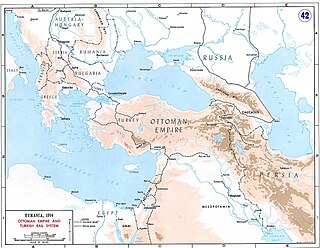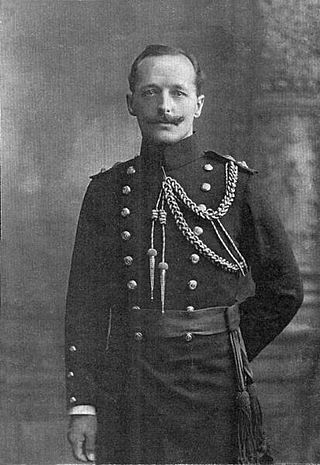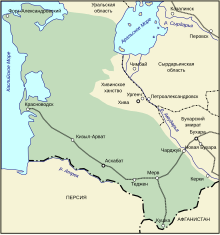
The Russian Civil War was a multi-party civil war in the former Russian Empire sparked by the overthrowing of the social-democratic Russian Provisional Government in the October Revolution, as many factions vied to determine Russia's political future. It resulted in the formation of the Russian Socialist Federative Soviet Republic and later the Union of Soviet Socialist Republics in most of its territory. Its finale marked the end of the Russian Revolution, which was one of the key events of the 20th century.

Anton Ivanovich Denikin was a Russian military leader who served as the acting supreme ruler of the Russian State and the commander-in-chief of the armed forces of South Russia during the Russian Civil War of 1917–1923. Previously, he was a general in the Imperial Russian Army during World War I.

The Allied intervention in the Russian Civil War consisted of a series of multi-national military expeditions that began in 1918. The initial impetus behind the interventions was to secure munitions and supply depots from falling into the German Empire's hands, particularly after the Bolsheviks signed the Treaty of Brest-Litovsk, and to rescue the Allied forces that had become trapped within Russia after the 1917 October Revolution. After the Armistice of 11 November 1918, the Allied plan changed to helping the White forces in the Russian Civil War. After the Whites collapsed, the Allies withdrew their forces from Russia by 1925.

The Transcaspian Oblast, or simply Transcaspia, was an oblast of the Russian Empire and early Soviet Russia to the east of the Caspian Sea during the second half of the 19th century until 1924.

The Trans-Caspian Railway is a railway that follows the path of the Silk Road through much of western Central Asia. It was built by the Russian Empire during its expansion into Central Asia in the 19th century. The railway was started in 1879, following the Russian victory over Khokand. Originally it served a military purpose of facilitating the Imperial Russian Army in actions against the local resistance to their rule. However, when Lord Curzon visited the railway, he remarked that he considered its significance went beyond local military control and threatened British interests in Asia.

Dunsterforce was an Allied military force, established in December 1917 and named after its commander, Major-General Lionel Dunsterville. The force comprised fewer than 350 Australian, New Zealand, British and Canadian officers and NCOs, who were drawn from the Western and Mesopotamian fronts. The force was intended to organise local units in northern Iran (Persia) and South Caucasus, to replace the Tsarist army that had fought the Ottoman armies in Armenia. The Russians had also occupied northern Iran in co-operation with the British occupation of southern Iran, to create a cordon to prevent German and Ottoman agents from reaching Central Asia, Afghanistan and India.

The 26 Baku Commissars were Bolshevik and Left Socialist Revolutionary (SR) members of the Baku Commune. The commune was established in the city of Baku, which was then the capital of the briefly independent Azerbaijan Democratic Republic, and is now the capital of the Republic of Azerbaijan. The commune, led by Stepan Shahumyan, existed until 26 July 1918 when the Bolsheviks were forced out of power by a coalition of Dashnaks, Right SRs and Mensheviks.
Reginald Teague-Jones MBE was a British political and intelligence officer. He was active in the Caucasus and Central Asia during the Russian Civil War. For the last 66 years of his life he was known as Ronald Sinclair. Under that assumed name, he authored two published accounts of his travels and adventures in Asia and the Middle East.

The Russian Civil War (1917–1921) began after the provisional government collapsed and the Bolshevik party assumed power in October 1917. The principal fighting occurred between the Bolshevik Red Army and the forces of the White Army, a group of loosely allied anti-Bolshevik forces. During the war several foreign armies took part, mostly fighting against the Red Army—including the Western allies—and many foreign volunteers fought for both sides. Other nationalist and regional political groups also participated in the war, including the Ukrainian nationalist Green Army, the Ukrainian anarchist Insurgent Army and Black Guards, and warlords such as Ungern von Sternberg. Despite some pressure from Britain, the Australian Prime Minister, William Hughes, had refused to commit forces to Russia following the end of World War I in 1918.

Major-General Sir Wilfrid Malleson was a major-general in the British Indian Army who led a mission to Turkestan during the Russian Civil War.

The Tashkent Soviet was a public organisation set up in Tashkent during the Russian Revolution. It was established on 2 March 1917 at an inaugural meeting that consisted of thirty five workers from the Central Asian Railway. It was headed by a technician named I. I. Bel'kov. The following day, there was a meeting in the local Duma which set up an Executive Committee of Public Organisations to manage the "sociopolitical and economic life of the city".

The Transcaspian Government was a "Menshevik-Socialist Revolutionary" coalition set up by the railway workers of the Trans-Caspian Railway in 1918. It was based at Ashgabat, Transcaspian Oblast.

Fyodor Adrianovich Funtikov was Chairman of Provisional Executive Committee of the Transcaspian Region Soviet during the period July 1918 – Jan 1919. He was a Socialist Revolutionary railway worker, who in his role as head of the Transcaspian Government was held responsible for the execution of the 26 Baku Commissars.

Colonel Charles Howard "Dick" Ellis (1895–1975) was an Australian-born British intelligence officer credited with writing the blueprint for United States wartime intelligence agencies Coordinator of Information and Office of Strategic Services, what would become the CIA. For his contribution to the United States in World War II, he received the Legion of Merit from President Harry S. Truman.

The Armed Forces of South Russia (AFSR or SRAF) (Russian: Вооружённые силы Юга России, romanized: Vooruzhyonniye sily Yuga Rossii, VSYuR) were the unified military forces of the White movement in southern Russia between 1919 and 1920.

The Kuban Offensive, also called the Second Kuban Campaign, was fought between the White and Red Armies during the Russian Civil War. The White Army achieved an important victory despite being numerically inferior in manpower and artillery. It resulted in the capture of Ekaterinodar and Novorossiysk in August 1918 and the conquest of the Western part of Kuban by the White armies. Later in 1918 they took Maykop, Armavir and Stavropol, and extended their authority over the entire Kuban Region.

The Turkestan Army was a White army during the Russian Civil War, which operated from January 1919 to February 1920, in the Transcaspian Oblast area.
The Ural Separate Army was a military formation of the White Army during the Russian Civil War, which operated in the Volga region and the Southern Urals and was formed on December 28, 1918 from units of the Ural Cossack Army and other military units within the Urals Region.
The Turkestan Military Organization was an anti–Bolshevik military underground organization created in February 1918 in the Turkestan Territory of the Russian Empire, with its center in the city of Tashkent, a group of former officers of the Tsarist Army and a number of representatives of the Russian intelligentsia and officials of the former administration of the Territory with the aim of overthrowing Soviet Power in the province.
The Battle of Artyk took place on 12 August 1918 during the Russian Civil War between a British Indian expeditionary force of mostly Punjabi soldiers and a Bolshevik revolutionary force. The location of the combat was in Transcaspia near modern Artyk, Turkmenistan, close to the border between the former Russian Empire and the former Imperial State of Persia.
















